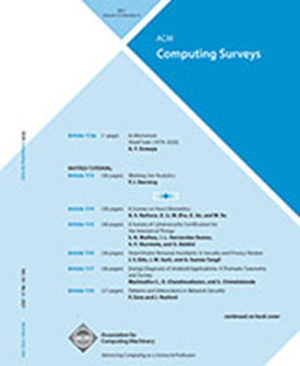用于人类活动识别的 Wi-Fi 传感技术:简要调查、潜在挑战和研究方向
IF 23.8
1区 计算机科学
Q1 COMPUTER SCIENCE, THEORY & METHODS
引用次数: 0
摘要
无线通信技术的最新进展使 Wi-Fi 信号在个人和专业环境中都变得不可或缺。利用这些信号进行人类活动识别(HAR)已成为一项尖端技术。与传统的视觉监控方法相比,利用 Wi-Fi 信号的波动进行人类活动识别(HAR)可增强隐私性。这种技术的精髓在于检测 Wi-Fi 信号与人体相互作用时的微妙变化,然后通过先进的算法捕捉和解读这些变化。本文首先概述了 HAR 的主要方法和非接触式传感的发展,分别介绍了基于传感器的识别、计算机视觉和基于 Wi-Fi 信号的方法。然后,论文探讨了基于 Wi-Fi 的 HAR 信号采集工具,并列出了几个高质量的数据集。随后,论文回顾了通过 Wi-Fi 信号识别实现的各种传感任务,重点介绍了深度学习网络在 Wi-Fi 信号检测中的应用。第四部分介绍了评估不同网络能力的实验结果。研究结果表明,神经网络的泛化能力存在很大差异,各种运动分析的测试准确性也存在明显差异。本文章由计算机程序翻译,如有差异,请以英文原文为准。
Wi-Fi Sensing Techniques for Human Activity Recognition: Brief Survey, Potential Challenges, and Research Directions
Recent advancements in wireless communication technologies have made Wi-Fi signals indispensable in both personal and professional settings. The utilization of these signals for Human Activity Recognition (HAR) has emerged as a cutting-edge technology. By leveraging the fluctuations in Wi-Fi signals for HAR, this approach offers enhanced privacy compared to traditional visual surveillance methods. The essence of this technique lies in detecting subtle changes when Wi-Fi signals interact with the human body, which are then captured and interpreted by advanced algorithms. This paper initially provides an overview of the key methodologies in HAR and the evolution of non-contact sensing, introducing sensor-based recognition, computer vision, and Wi-Fi signal-based approaches, respectively. It then explores tools for Wi-Fi-based HAR signal collection and lists several high-quality datasets. Subsequently, the paper reviews various sensing tasks enabled by Wi-Fi signal recognition, highlighting the application of deep learning networks in Wi-Fi signal detection. The fourth section presents experimental results that assess the capabilities of different networks. The findings indicate significant variability in the generalization capacities of neural networks and notable differences in test accuracy for various motion analyses.
求助全文
通过发布文献求助,成功后即可免费获取论文全文。
去求助
来源期刊

ACM Computing Surveys
工程技术-计算机:理论方法
CiteScore
33.20
自引率
0.60%
发文量
372
审稿时长
12 months
期刊介绍:
ACM Computing Surveys is an academic journal that focuses on publishing surveys and tutorials on various areas of computing research and practice. The journal aims to provide comprehensive and easily understandable articles that guide readers through the literature and help them understand topics outside their specialties. In terms of impact, CSUR has a high reputation with a 2022 Impact Factor of 16.6. It is ranked 3rd out of 111 journals in the field of Computer Science Theory & Methods.
ACM Computing Surveys is indexed and abstracted in various services, including AI2 Semantic Scholar, Baidu, Clarivate/ISI: JCR, CNKI, DeepDyve, DTU, EBSCO: EDS/HOST, and IET Inspec, among others.
 求助内容:
求助内容: 应助结果提醒方式:
应助结果提醒方式:


